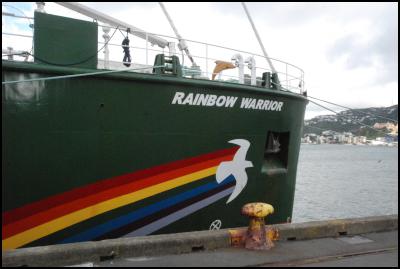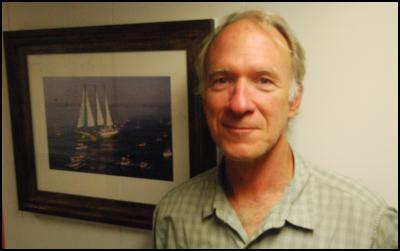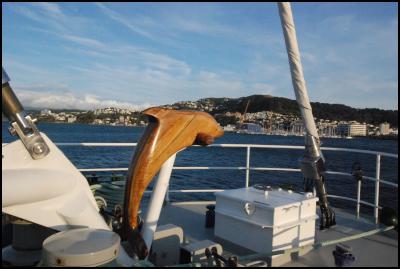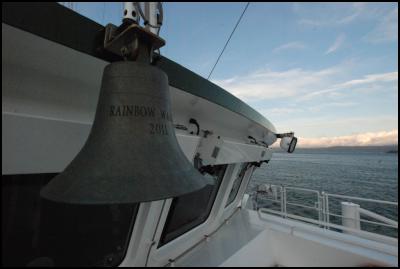All Aboard? - Sustainability Debate on the New Rainbow Warrior
By Mark P. Williams

Last week saw the arrival in Wellington harbour of the new Rainbow Warrior and the release of Greenpeace's 'Future Is Here' report. To mark the publication of the report Greenpeace held a debate on environmental sustainability for the three major parties on board the ship.
Representatives from the National, Labour and Green Parties were given opportunities to answer important questions about how their policies would help New Zealand create a sustainable future. The Greens were represented by their Co-leader Russell Norman; the Labour Party by Deputy Leader Grant Robertson, Labour Spokesperson for the Environment; and the National Party by Nicky Wagner, Chair of the Environment Select Committee and Chair of the BlueGreens Caucus Committee.
The event was chaired by veteran business journalist Rod Oram, whose steering hand maintained the focus of the debate.
Each speaker was given the opportunity to explain how they saw the relationship of the central questions of sustainability to their vision for the future of New Zealand.
All three debaters were asked to respond to the primary question:
Clean energy - It's here, it's global and it's only going to get bigger. What is your party going to do to make sure NZ seizes these economic opportunities?
The debate was broadcast live.
(Source: http://www.greenpeace.org/new-zealand/en/campaigns/climate-change/Debate/)
Russell Norman's speeches marked out clear sets of expectations and articulated the problem in terms of economic sector development. Norman suggested that the current government was placing its infrastructural emphasis on the wrong economic sectors: investing in extractive industries rather than research and development of ITC; and investing in raw dairy and agricultural export rather than what he called 'value added' products. He suggested that one of the benefits of New Zealand being a small country, or a 'village society', is the nation's ability to choose strategic directions, such as investing in green industries, which will have a larger and longer term effect for the country. He stated that New Zealand required nothing short of a revolution in its attitudes toward sustainability.
Nicky Wagner's speeches countered Russell Norman by insisting on taking an 'evolutionary' rather than 'revolutionary' approach, which she interpreted as meaning a more gradual movement towards a sustainable economy. She focused enthusiastically on the possibilities of technological innovation as a solution, while insisting on taking a 'Holistic' approach to the balance of economic pressure and environmental preservation. She spoke about New Zealand's world-leading position in geothermal power and suggested that biotechnology was another area that the government was interested in developing further.
Grant Robertson's responses stood out for stating the case in the most concrete terms, related to the lives of ordinary New Zealanders while also adhering very strongly to the central problem and complementing the thrust of Russell Norman's argument. He spoke about the need for reconcile 'living within our limits' to the desires and expectations that New Zealander's have for their lifestyles, saying clearly that an environmentally sustainable future requires a change of economic expectations.. He said that there needed to be 'a quantum shift' in levels of investment in innovation in New Zealand but that at present the government was only taking small steps. His more general political call was for leadership from the government, directing the course of the New Zealand economy by investing in innovation.
The three party representatives then took a few questions from environmental journalists and activists.
Questions
Party representatives were asked how they reconciled words like 'evolutionary' with the government's stated priority for oil and gas exploration which were effectively ensuring that New Zealand was left with a legacy of increased greenhouse gas emissions.
Nicky Wagner responded by reiterating that there was a need to take a holistic point of view, starting with looking at investing in energy efficiency, insulating homes and businesses.
Grant Robertson suggested that the present mechanisms, such as the Emissions Trading Scheme, which was the government's primary means of regulating greenhouse gas emissions, were simply inadequate to addressing the need for change, adding that he felt that the ETS had become more of a bureaucratic exercise.
Russell Norman concurred but emphasised that the ETS was always a marginal measure, while more significant reductions could only be achieved by regulation but the political will to do so had been drained by framing it in terms of 'Nanny State' interventionism.
Another questioner asked why the word 'sustainability' had been removed from government documentation and policy. Nicky Wagner said that the government was very much committed to sustainability, and that the question of what was meant by 'sustainability' was precisely the nature of the debate.
Bunny McDairmid from Greenpeace concluded the debate by saying that it was incompatible with the present environmental and economic situation to consider the problems faced by New Zealand in 'holistic' terms. She said that New Zealand is in a unique position as a small country with enormous potential to develop a clean economy and it was time for New Zealanders to make a decisive choice.
After the debate we were given a fascinating tour around the ship by Captain Joel Stewart. He explained how sustainable energy policies were integrated into every detail of the ship's specifications. This ranged from its use of lower density steel in the hull to enable it to maximise the use of sail power, to the use of hydraulic and electric motors for the rigging which enabled the sails to be set by only two crew members at any one time.
The new Rainbow Warrior is an example of how sailing ships can be made commercially viable in the future; it is a living, working example of sustainability and innovation unified to a specific purpose. As it sails away from New Zealand to undertake its first circumnavigation of the globe, we should all hope that it leaves a bit of its spirit on these shores.


Captain Joel
Stewart

Dave the Dolphin facing
across Wellington Harbour

ENDS




 Peter Dunne: Luxon Gets Out His Butcher's Knife - Briefly
Peter Dunne: Luxon Gets Out His Butcher's Knife - Briefly Binoy Kampmark: Warring Against Encryption, Australia Is Coming For Your Communications
Binoy Kampmark: Warring Against Encryption, Australia Is Coming For Your Communications Gordon Campbell: On Fast Track Powers, Media Woes And The Tiktok Ban
Gordon Campbell: On Fast Track Powers, Media Woes And The Tiktok Ban Binoy Kampmark: Censorship Wars, Elon Musk, Safety Commissioners And Violent Content
Binoy Kampmark: Censorship Wars, Elon Musk, Safety Commissioners And Violent Content Gordon Campbell: On The Public Sector Carnage, And Misogyny As Terrorism
Gordon Campbell: On The Public Sector Carnage, And Misogyny As Terrorism Ramzy Baroud: NATO’s Never-ending War: The 75-Year-Old Bully Is Faltering
Ramzy Baroud: NATO’s Never-ending War: The 75-Year-Old Bully Is Faltering